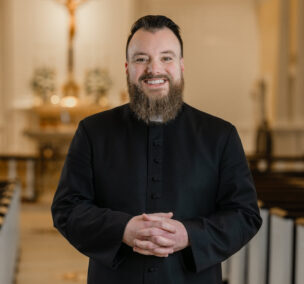Dear Brothers and Sisters in Christ,
Today the Church celebrates the Third Scrutiny for those entering the Church at the Easter Vigil. Having reflected on the Gospel stories of the Samaritan woman at the well and the healing of the man born blind, we now reflect on Jesus raising his friend Lazarus from the dead. The Scrutinies have drawn our attention to the desire of God for a relationship with us, just as Jesus engages the Samaritan woman in conversation and leads her both to conversion and to become an evangelist. They also point us to the ways that God desires to restore what is broken in us, to lift the veil that blinds us to God’s grace, as the man born blind is given the gift of sight for the first time. These are also moments in which God reverses the effects of sin in our lives. Sin breaks our relationship with God, but Jesus comes to us to reconcile us in that bond. Sin blinds us to God’s goodness and mercy, but Jesus heals our blindness. Finally we come to the raising of Lazarus from the dead, and we realize that sin destroys our spiritual life. To be cut off from relationship with God, to be blind to His goodness and grace, is to experience spiritual death. And not just spiritual death, but the bodily death that is the consequence of original sin. In raising Lazarus from the dead, Jesus is preparing us for two resurrections: His, on Easter Sunday, and our own bodily resurrection on the last day.
For those who believe, death is not the end, the Church’s funeral rites proclaim. Rather, when this mortal body lies in death, we await the day when we will be raised up to share in the resurrection of Christ. In the words and actions of Martha and Mary, we see a reflection of our own processing of grief in the face of death. Their responses are perfectly understandable and appropriate. Jesus first promises resurrection, which seems outrageous. But then he commands Lazarus to come out of the tomb and the dead man rises. Suddenly resurrection, new life, life after death, all of these things do not seem so strange. Rather, through the eyes of faith we are invited to contemplate the mystery and to hope for life, even as we confront death and grave.
While the Scriptures we have read these last three Sundays point us to the way that God is restoring fallen humanity, the Church does something that might seem odd. The statues and images in the Church, except for the Stations of the Cross, are covered. We are entering upon the last days of Lent, traditionally called Passiontide. Covering the statues encourages us to focus less on earthly beauty, and by visually fasting, to ask God for greater spiritual vision to see and know His mercy and grace. The covered images also reflect something that the Scriptures have told us in these weeks: that while the Samaritans are able to receive Jesus, His own people reject Him; the once-blind man who has little education in the Scriptures is ridiculed by the Pharisees, the experts, but Jesus calls them blind; Lazarus is raised from the dead, but even with that great sign, many still refuse to believe Jesus. This is the tension in which we live at every moment. While we believe and strive to be disciples of Jesus, we sometimes find ourselves struggling to believe, feeling distant from God, or spiritually dead. We live in a world that, like the Pharisees, might mock us for our faith. The covered images of Passiontide give us a stark reminder of that tension. In all of this there is good news! The tension we experience now will be resolved with the celebration of the Easter mysteries, and in the most perfect and complete way, when Christ comes again in His glory!
Peace,
Fr. Sam


